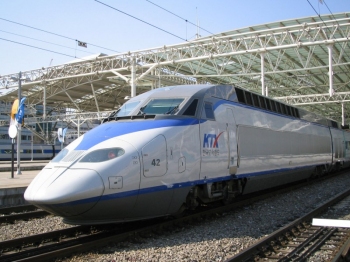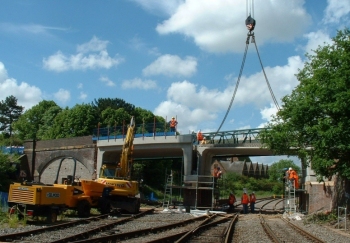 Case
Study Case
Study
Pilsen Footbridge
- Analysis and assessment of the
behaviour of a dynamically sensitive footbridge
- Pedestrian load modelling to EN
1991-2 (Draft version)
- Optimisation and installation
of a tuned mass damper for pedestrian comfort

Pontex Consulting
Engineers Ltd. used LUSAS Bridge to assist with its analysis and
assessment of the dynamic behaviour of a slender decked, steel cable
stayed bridge on behalf of the Roads and Motorways Directorate of
the Czech Republic. Finite element analysis and dynamic loading
tests showed that the structure was susceptible to pedestrian
loading, and especially by vandalism, meaning that an energy
dissipation device needed to be installed. After the design and
installation of a tuned mass damper a second dynamic loading testwas
carried out, proving the effectiveness of the installed unit.
Overview
|
Pilsen Footbridge is a cable
stayed footbridge that spans around 65m across the D5
motorway near Plzen in the Czech Republic. The steel box
girder deck is supported by three pairs of 40mm diameter
fore-stays anchored into a 24m high, steel pylon which, in
turn, is anchored by three pairs of 50mm diameter back stays
into a substantial piled concrete foundation. The pylon has
a ball and socket joint at its base. The box girder is
supported by articulated steel bearings. During tender
design (by others) a tuned mass damper was seen to be
necessary. Final detailed design saw some re-design to parts
of the bridge but it remained very dynamically sensitive to
live load, showing that some form of passive damping was
still required.
|

|
|

|
|
Schematic
elevation of footbridge
|
Modelling with LUSAS
A 3D model was created in LUSAS to
examine the dynamic behaviour of the structure. Beam elements
represented the deck and pylon members and bar elements modelled the
cables. From the LUSAS analysis natural frequencies and mode shapes
for the structure were obtained and the first two modes in the
vertical direction were found to be within a specified problematic
range. As a result a pedestrian loading assessment was carried out
based on a draft copy of EN1991-2. This involved assessing three
pedestrian loading situations:
- A group of pedestrians modelled by
a pulsating single force. (Loading type 1)
- A constant stream of pedestrians
modelled by a pulsating constant uniform load (Loading type 2)
- Vandalism where a group of ten people are effectively
jumping up and down together at
problematic frequencies. (Loading type 3)
Two models of the footbridge, one
without a tuned mass damper, and one with, were created and an
optimisation of TMD parameters was carried out. Dynamic response of
the structure was investigated using the modal superposition method
involving step-by-step analysis.
|

|

|
|
1st vertical
bending mode (without a TMD installed).
Natural frequency = 1.33 Hz |
2nd vertical
bending mode (without a TMD installed).
Natural frequency = 2.93 Hz |
| |
|
Calculated
dynamic responses to pedestrian loading
Welded steel structures generally
have very low damping. A viscous
damping ratio of 0.5% was therefore used for all mode shapes
in the dynamic analysis. For pedestrian
comfort, and in addition to having to meet specified displacement criteria, an acceleration
comfort value of less
than 0.7m/s2 had to be met. From LUSAS analyses of the
three pedestrian loading types it was seen that this value was
greatly exceeded by the group of pedestrian loading (1.8m/s2),
let alone a moving stream of people (11m/s2), so the
installation of a tuned mass damper was
chosen as the best solution to reduce the structural response.
|

|

|
|
Displacement response from a
group and flow (stream) of pedestrians (loading types 1 and
2) |
Acceleration response from a
group and flow (stream) of pedestrians (loading types 1 and
2) |
|

|

|
|
Acceleration
response from vandalism loading
(loading type 3) |
Summary of
maximum accelerations and displacements for pedestrian
loading types 1,2 3 and 3 |
Tuned Mass Damper
assessment
| A
LUSAS analysis to assess the installation of a tuned mass
damper was carried out using TMD parameters that were chosen according to Bachmann and Weber
(1995). This resulted in a modal mass of 2 tonnes being used
along with a frequency of 0.95 of the natural frequency of the
structure that was to be damped. The results showed that vertical
acceleration at the critical location in the deck would be
reduced to just 0.1m/s2 for the pedestrian group
loading and 0.56m/s2 for the flow (stream) of
pedestrians. Acceleration response due to vandalism was
similarly reduced to a value of 0.5m/s2,
satisfying this particular comfort criteria. Maximum
vertical displacement values were also substantially
reduced. The maximum displacement caused by a flow of
pedestrians, for example, reduced from 158mm to just 6mm. |

Calculated
acceleration
response from vandalism loading
(with a TMD installed) |
In Situ Dynamic
Loading Tests
After the final construction works
had been carried out the bridge was subjected to an in situ dynamic loading
test. The aim was to measure the natural frequencies, derive mode
shapes, evaluate the response of the structure to different types of
human loading and assess initial damping requirements. A variety of
walking, swaying and running loadcases were undertaken at critical
frequencies of the first and second vertical bending modes and this
included a vandalism case of ten people swaying at the location where
the displacement in the deck would be greatest for the first
vertical bending mode. Measured results were compared against those
calculated by LUSAS and found to be in good agreement. At the
time of this first loading test the mass of the real footbridge was
less than the mass of the LUSAS models but allowance was made for
this in the final design of the TMD.
The installed tuned mass damper
parameters were based upon the results of the first in situ dynamic
loading test and on Pontex Ltd’s stated requirements. Four viscous
dampers with a combined damping value of 1500Ns/m were employed in
a pair of units that were located inside the deck 30.6m from the end furthest
from the pylon.
|

|

|
| Tuned
Mass Damper installation |
Following the installation of the TMD
the same dynamic pedestrian loading as used on the first test was
carried out on the footbridge. Measurements showed that, with the
TMD fitted and for the critical case of deliberate
vandalism, the acceleration in the deck was reduced to just
one-tenth of its previous value.
|

|

|
|
Measured
response of the deck to vandalism loading (without and with
TMD installed) |
|
|

|
|
Completed
structure |
"By using LUSAS we obtained a good correlation of the measured
frequencies and successfully designed and tested a tuned mass damper to restrict
deck movement for all the pedestrian loadings that were considered."
Milan
Kalný,
Technical Director, Pontex Consulting Engineers Ltd.
Find out more
Other LUSAS Bridge case studies:
|



















